Setting the Bait the Right Way
If you’re going to do your own bear baiting, here are some tips.
– By Bill Wiesner
A broadside shot is, by far, the preferred shot angle, with a quartering-away shot the only other sensible option. Head-on shots are acceptable only for centerfire rifles with the power to send a bullet through heavy bone protecting the bear’s vitals, but even that is not a preferred shot angle.
How to get the bear to stand sideways, which is what you want? For years, I built bunkers of wood and brush, trying to force the bear into a broadside position. However, the added brush at a bait site was an eyesore to the hunter and an alarm bell to the bear. Big bears will be extremely cautious approaching something that seems out of place. A low wall of logs, maybe 30 inches high so the bear won’t climb over, tied to a couple of trees or posts on the far side of the bait might work. The logs would need to be long enough to prevent bears from reaching the bait at a 45-degree angle facing you.
A “V” of Logs was standard
A ‘V’ of logs used to be the standard setup, with the bait covered by short, heavy chunks of wood or longer sections teepeed on a five-gallon bucket. The bait would be inside the ‘V’ at the base, or in the same location in a five-gallon bucket, usually giving you a quartering away shot but also a broadside shot if the wings of the ‘V’ were wide enough and long enough. You might want to tie the bucket to one of the logs forming the ‘V’; bears have been known to grab the bucket and run off with it. The last thing you’ll see is a swiftly moving white bucket racing down the bear trail.
Double 5-gallon buckets
Some hunters use a double-bucket system, with a white five-gallon bucket set inside a black five-gallon bucket. The black bucket is hung on a tree at five feet height. This controls the bear, you know it is a shooter bear, and you have a pretty accurate idea of its size.
Put the bait in the bottom of the black bucket, the white bucket inside and on the top of the black bucket. Fill the white bucket with sticks to slow down the bear and offer a shot. The white bucket keeps rain out and keeps raiding birds and animals from stealing the bait.
If a bear chews on the black bucket bottom edges, it punches holes with its teeth. Cooking oil in the bait leaks out and creates a permanent scent on the ground. This scent attracts and holds bears in the area.
Take the buckets out when you leave. This trains bears to hit during shooting hours. Expect to take seven to 10 days to condition a bear to hit at the right times.
Parallel dead spruce
If you want to irritate a bear big time, lay half a dozen downed, dead spruce about 15-18 feet long side by side, with tips together and roots together. Find dead trees with branch stubs remaining, so the treetops will lock together. Dig a hole or find a natural depression under the bases of the trees. Put the bait there.
A bear attracted to the bait will swat a spruce base out of the way to get at the bait. That is, it will think it is getting the spruce obstruction out of the way. However, the interlocked treetops will act like a hinge, with the tree base swinging back into place as the bear sticks its head down in the depression to grab a mouthful of bait. The bear’s butt end will be sticking up high, because it will be standing on the other dead spruce part of the bait. When the swatted spruce swings back into line, chances are it whacks the bear a good wallop on the butt, and if the tree’s base has root stubs, often a stub jabs it in the butt.
This really irritates the bear. It reacts quickly, whacking another dead spruce, or the same one, out of the way, which swings back and whacks the bear in the butt again.
One more whack results in an even more enraged bear, and you want to laugh out loud.
I’ve not tried this bait covering, but a buddy has. He laughed the whole time he told me about it. He also shot that totally distracted, highly enraged bear.
Logs crisscrossed in layers
A variation on bait-in-the-hole — use logs four to six feet length, piled in layers in alternating directions (N-S, E-W). This slows the bear down.
Barrels with a hole in the side
If barrels are legal where you hunt, cut an eight-inch hole in the middle of an upright 55-gallon barrel, then chain the barrel to a tree in such a position that the hole is at a 90-degree angle to your stand. Fasten the barrel securely so no bear cannot move it. Put bait in the barrel through the hole and sprinkle a bit of it atop the barrel or on the ground for breezes to blow bait scent into nearby cover.
Why an eight-inch hole? A really good-sized bear won’t be able to get its head in the hole and often will, instead, reach into the hole with a paw to get bait. The hole is a sizing ring.
Jeff Brunn, a good friend and avid bear hunter, devised a neat, efficient way to force the bear to feed broadside.
Bury a stump at an angle
Bury about 18 inches of a hollow stump in the ground at a 45-degree angle, then cut off the top of the stump parallel with the ground surface. It is nearly impossible for a bear to get bait out of the hollow stump unless it lines itself up with the angled stump pointing toward it. By placing the angle of the stump 90 degrees to your stand the bear will have to stand broadside to you to get at food in the buried stump.

A hollow stump buried in this position forces a feeding bear to stand in one place to get at the bait. Set properly, the bear will be broadside to your stand, which is exactly what you want.
Ask a local logger if he has any hollow logs. A piece about three feet long works well. At the bait site, bury about one foot of the log in the ground at a 45-degree angle. Once the stump is in place, cut off the top parallel with the ground. This forces the bear to stand broadside to your position to get all the bait inside the stump. This natural looking bait site also makes a bear more comfortable to move in and feed prior to dark. Make note of the various positions you may sit, to determine exact placement of the log.
Variation on a buried stump
There are other ways to go about this, too. A ‘shotgun’ metal pail, a piece of eight-inch or larger PVC pipe (painted black), or a five-gallon plastic bucket (also painted black) will work and not spook the bear. Any one of them could be buried at the proper angle. Cutting the bottom out of the pails will allow drainage, should water get into the bucket, and will keep the bait in better condition. All of the pails should be removed after the season; in fact, that may be a game law requirement.
You could simply dig a hole in the ground and put bait in the hole. Drawback here is that you won’t have any control over positioning the bear for a good shot.
Baits that work
We use sweets, fryer grease and granola for bait placed in the stump.
Fryer grease, or Crisco with bacon grease or liquid smoke mixed in it, can be smeared on a log or logs at the bait site. Bears will spend time licking the bacon-scented grease from the log.
You also can mix a sweet aroma, such as strawberry, with water, then dump the scented water on spruce trees or leafed-out bushes at the bait. Bears will be attracted to the berry scent.
Avoid chocolate
There is one food item – chocolate – to stay away from. Its use as a bait item is banned in some states and restricted in others because it causes heart failure in animals. Chocolate contains theobromine, an alkaloid found naturally in chocolate. Theobromine exists in different levels in various types of chocolate and is most intense, of course, in blocks of chocolate. Baker’s chocolate and dark chocolates have the most theobromine; milder chocolates have the least. Small amounts, such as found on the surface of some baked snacks, should be ok; that type of baked goodie has been used for baits a long time. However, there are better ways to appeal to a bear’s sweet tooth.
Honey burns also are illegal in some places.
Peanut butter is great!
On the other hand, one scent item – peanut butter – fortunately is ok to use. That’s great, because it is fun to smear on a log or a tree and watch bears try to dislodge it when it sticks to their tongue, gums and roof of their mouth.
No matter the bait, use small bait pieces. Bears will stay on the bait instead of running back into the brush with the bait, as they might to eat a large bait piece.
You want only one person’s scent going to the bait, so all bears hitting that particular bait associate that person’s smell with food.
Mark the area with fryer grease
One more step and you’ll be ready to go: rake bare a one-foot-wide area around the bait. Saturate the bare area with old fryer grease. The bear will carry scent to a larger area, into places you most likely want to keep your scent out of. They will do your drag bag work for you.
BILL WIESNER
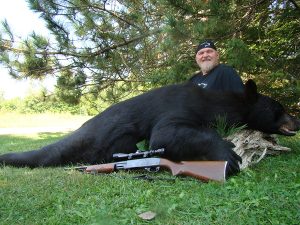
Bill and his largest black bear, a Wisconsin trophy that scored 21-15/16 and weighed 510 pounds. He shot it a bait near a plowed field with what had been his father’s .30-06. Photo by Bill Wiesner.
Bill “Bearcrazy” Wiesner knows bears and bear hunting. He has taken 57 black bears. He, his wife and two sons have taken more than 100, 30 of which qualify for the Pope & Young record book and seven of which qualify for the Boone & Crockett record book.
The book has ten hunting how-to chapters and 10 memoir chapters.
How-to chapters include black bear natural history; distribution, population & record book entry totals (by state and province); hunting gear (rifle, slug gun, handgun, muzzleloader, bow, crossbow), camo, and other necessary bear hunting items; hunting from ground blinds; hunting styles (D-I-Y, guided, hounds, spot-and-stalk); scouting; baiting and scents; new twists (food plots, calling, decoying); the shot (before, during, after); care of hide for taxidermy; care of meat (processing, freezing, recipes).
Memoir chapters — all entertaining reading — include strange or unusual incidents, personalities and bears encountered, plus family involvement during the author’s years of growth as a bear hunter.
He and his family have taken bears over baits, by spot and stalk, and behind hounds. They have taken them with selfbow, recurve bow, longbow, compound bow, crossbow, muzzleloader, rifle and shotgun with slugs.,
Bill was the first hunter to receive all five (coyote, bobcat, turkey, deer, bear) Wisconsin Bowhunters Association pin awards for animals taken in one season. This is extremely difficult, due principally to Wisconsin’s point system for issuing bear tags.
He is a member of the “Red Arrow Society”, awarded by the Lakota Sioux Nation for archery contributions to the tribe. This award is rarely given to a non-tribal member.
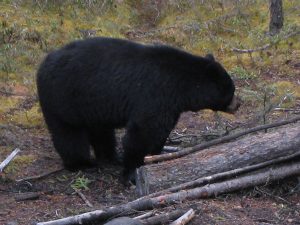
A Manitoba shooter bear thinking things over. Its near front leg needs to be forward for a good bow shot.
Photo by Glenn Helgeland
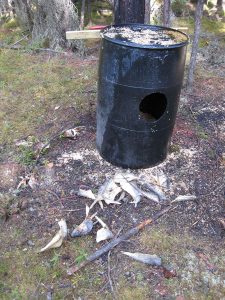
A well set up barrel bait, chained to a tree so the bear can’t move it. The eight-inch diameter hole cut in the barrel qualifies a bear hitting the bait. If it can’t get its head in the hole, it is a shooter. It will reach a paw into the hole for bait. A shooter bear’s back will be above the top ring; when it’s back is nearly level with the top of the barrel, it is a nice bear. Barrel must have the hole facing left or right from the stand, so the hunter will get a nice broadside shot. Bears paid no attention to the fish skins.
Photo by Glenn Helgeland
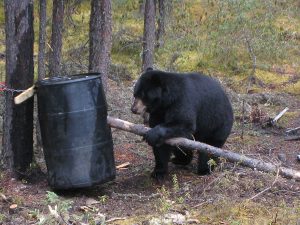
Nice bear, pulling heavy stick out of the hole in the barrel so it can get at bait in the barrel. Photo by Glenn Helgeland
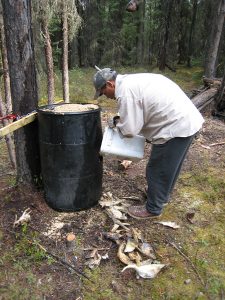
Re-baiting the barrel. Photo by Glenn Helgeland
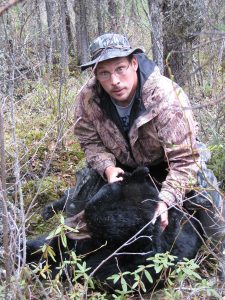
Jim Price shot the bear in the above photos, the day after I moved to a different stand. it was his first bear. Photo by Glenn Helgeland
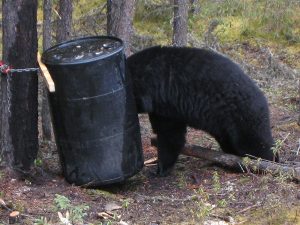
The bear could just barely get its head in the barrel hole. Its near front leg should be further forward for a good bow shot. Photo by Glenn Helgeland.
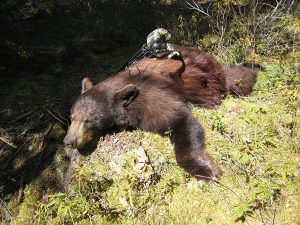
When this bear showed up, I knew I wanted it. It had a three-tone pelt. It was average size but gorgeous. Photo by Glenn Helgeland.
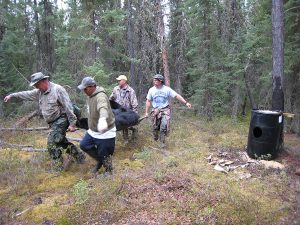
Using a stretcher to take out Jim Price’s bear. Much better than dragging and no rope burns on hide, no torn hair. Photo by Glenn Helgeland
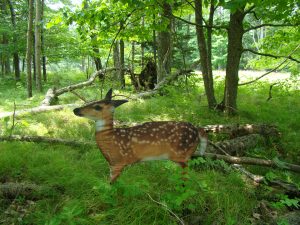
Bears prey on young fawns, so try a decoy and see what happens. Bill Wiesner is dressed in a ghillie suit in some trees behind the fawn.
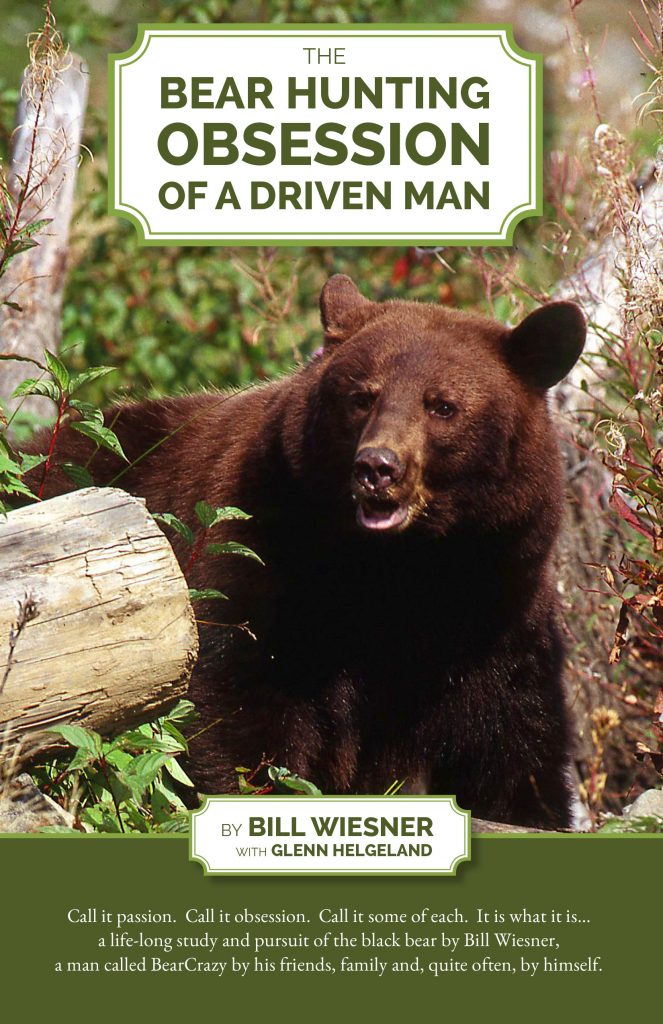
Front cover of Bill’s book The Bear Hunting Obsession of a Drive Man.

